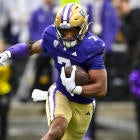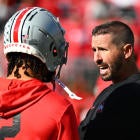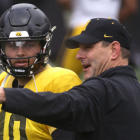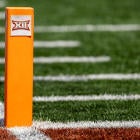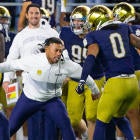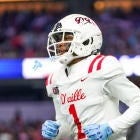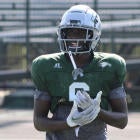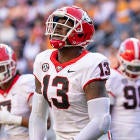
The second College Football Playoff semifinal game on New Year's Day features a couple of top 10 offenses in the country going toe-to-toe as two coaches on the rise look to punch their first-ever ticket to the CFP National Championship.
No. 2 Washington is making its second appearance in the College Football Playoff, last losing in the semifinals to Alabama in 2016. No. 3 Texas, on the other hand, is not only making its first College Football Playoff appearance but is also coming off its first Big 12 Championship since 2009 -- the season after which the Longhorns came up short in the BCS National Championship Game to Alabama.
Kalen DeBoer, in his second year as Washington's coach, guided the Huskies to a 13-0 season that extended the nation's longest active winning streak to 20 games. DeBoer has plenty of experience competing for championships from his title-winning time at the NAIA level at Sioux Falls, but this is his first time coaching for the top prize at this level.
Texas coach Steve Sarkisian has been to the CFP before, though not with the Longhorns. He served as Alabama interim offensive coordinator for the CFP National Championship in 2016 after the departure of Lane Kiffin. He then served as the full-time offensive coordinator for the 2019 and 2020 seasons in Tuscaloosa, the latter of which ended with a national championship. In just three years, Sarkisian has guided Texas back to elite status, which made this 2023 performance a huge statement as the Longhorns prepare for an SEC move in 2024.
So what are the keys to winning the game when the Sugar Bowl kicks off on Monday night? Let's have a look.
College Football Playoff cases: No. 1 Michigan | No. 2 Washington | No. 3 Texas | No. 4 Alabama
Keys to the Sugar Bowl semifinal
1. Washington establishing the run
While Michael Penix Jr. is a proper MVP pick for Washington, the Heisman Trophy runner-up had plenty of help from an offensive supporting cast that delivered at every level. Even the star-studded wide receiving corps might be taking up too much of the conversation when breaking down the Huskies offense. Simply put, a huge reason for their success this season, especially later in the year, has been the ground game.
Running back Dillon Johnson was at his best when Washington needed him the most, averaging 136.6 yards per game across the final five wins of the season. His midseason emergence helped open up things for Penix and the passing game, and it came thanks to the hard work of an elite, Joe Moore Award-winning offensive line. Their physicality not just in the trenches but out on the perimeter helps spring so many of those explosive plays that have helped the Huskies offense perform at a top-10 level.
Facing Texas will likely mark the most difficult challenge in terms of blocking interior defensive linemen, however. Utah and Oregon both have very strong defensive fronts, but neither team has the one-two punch of size and talent that comes with Texas' T'Vondre Sweat and Byron Murphy II. The Longhorns will be looking to both clog running lanes and collapse the pocket on passing downs to create disruption and negative plays for Washington's offense. If Washington can't run the ball to keep the defense off balance, it will be more difficult for Penix to connect with those talented receivers on deep shots down the field.
2. Cat-and-mouse game of playcalling
One of the great Sugar Bowl talking points is wondering what these coaches and their staffs have cooked up with one month to prepare. Sarkisian has long been revered as an elite game planner and caller, breaking tendencies and exposing weaknesses in the defense with the way he mixes and matches his moves. But while Sarkisian has carried the reputation for a little bit longer, there is no shortage of similar respect for Washington coach Kalen DeBoer -- in particular his partnership with offensive coordinator Ryan Grubb.
The Huskies do an excellent job of staying multiple and moving those dangerous wide receivers around to get ideal matchups. When All-American wide receiver Rome Odunze slides into the slot and winds up one-on-one with a linebacker, for example, the defense is going to find itself on the losing end of that play nine times out of 10. When Texas or Washington took the field this year, you expected at least 10-14 points worth of explosive plays credited mostly to how the offense was set up and executed. So, now what happens when they face each other? The early advantages and in-game adjustments will be crucial in a game that's expected to be close and decided at the margins.
3. Ceiling and floor of Quinn Ewers
Arguably the two best performances of Quinn Ewers' season have come when the money is on the table. First, there was the 349-yard, three-touchdown performance against Alabama. Then, a 452-yard, four-touchdown blitzing of Oklahoma State in the Big 12 Championship Game to seal this CFP berth. But Ewers also had just four touchdowns and two interceptions in the three regular-season games after his return from a shoulder injury, with a completion percentage in each game that was lower than his season-ending average (70.7%).
Ewers' floor is still very good, with statistical rankings even in his worst performances that would put him in the conversation as a top-30 quarterback in the sport. But Ewers' ceiling, with elite accuracy on well-designed deep shots down the field, is a quality that stacks up among any quarterback in the country. When going toe-to-toe with one of the best quarterbacks in the country in Penix, Ewers being closer to his ceiling than his floor is going to make a big difference for Texas.
4. Can Texas shake red-zone woes?
Texas ranked in the top 10 nationally, averaging 475.9 yards per game. It's down at 16th in scoring (36.2 points per game), however. The gap between those two rankings can be attributed to the Longhorns' red zone touchdown rate, which too often this season allowed teams to hang around when Texas' offense was doing everything it needed to but punch the ball in the end zone.
Texas ranks No. 121 nationally in converting red zone opportunities into touchdowns, accomplishing that task on just 49.1% of its red zone attempts. Washington, meanwhile, ranks 19th nationally converting 70.3% of its red zone opportunities into touchdowns. In a game featuring two high-scoring offenses, holding teams to field goal attempts is a win for the defense. If Texas plays to its season average in those scoring opportunities, there will be more of a chance for Washington to keep pace in a shootout.
5. Clutch Huskies
Washington enters having won nine consecutive games by 10 points or less. Not only can no one else in the country claim they have won as many close games -- the Huskies' seven one-score victories are the most in the FBS this season -- but that streak of consecutive close wins puts Washington in the argument for one of the most clutch teams in modern college football history. This success in close games comes thanks to not only a program-wide effort, but in particular the trust between the coaches and players to execute in high-pressure moments.
Penix was quarterback at Indiana where DeBoer spent the 2019 season as offensive coordinator and quarterbacks coach. So when DeBoer got the Washington job three years later, he has already identified the perfect quarterback to run the Huskies offense. You're not going to find that kind of long-running relationship between all the coaches and players on the depth chart, but you are going to find a similar level of trust for a team that's been running hot with no intentions of slowing down.












